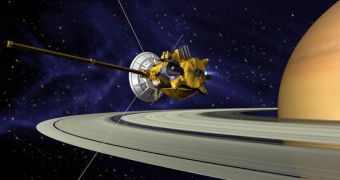A few days ago, the NASA Cassini spacecraft in orbit around Saturn put itself on safe mode, as a precautionary measure to defend itself against future harm, Experts are now trying to determine what is wrong with the orbiter, which has been at the gas giant for more than 6 years.
The mission, a collaboration of NASA, the European Space Agency (ESA) and the Italian Space Agency (ISA), is being managed by experts at the Jet Propulsion Laboratory (JPL), in Pasadena, California.
They announced that the spacecraft set itself in safe mode on 4 pm PDT (7 pm EDT, 2300 GMT) on Tuesday, November 2. Since then, Cassini has been sending back only telemetry related to engineering and spacecraft health.
All data flows from the probe have been suspended, as its scientific instruments have been shut down to prevent any potential damage. All spacecrafts have this safe mode, which prevents random glitches from causing widespread damage to the various systems.
Given the age of this particular probe, this behavior is indicated. Even if the malfunction is not that important, the spacecraft is programmed to await instructions from mission controllers, rather than try and fix the problem on its own.
It will remain around Saturn until 2017, as part of the extended mission it's currently on. During this time, it will carry out about 53 flybys of Saturn's largest moon Titan, as well as several of the ice-spewing Enceladus, and other of the gas giant's satellites.
However, the spacecraft is unlikely to recover from its glitch in time for a November 11 flyby of Titan, JPL mission controllers announce. This is the sixth time Cassini enters safe mode since reaching orbital insertion around Saturn, on July 1, 2004.
“The spacecraft responded exactly as it should have, and I fully expect that we will get Cassini back up and running with no problems,” explains the JPL Cassini program manager Bob Mitchell.
“Over the more than six years we have been at Saturn, this is only the second safing event. So considering the complexity of demands we have made on Cassini, the spacecraft has performed exceptionally well for us,' he goes on to add.
During its stay at Saturn, the probe has provided maps of Titan's liquid hydrocarbon lakes, of Enceladus' ice-spewing geysers, of the gas giant's rings and auroras and discovered several new moons around the planet.

 14 DAY TRIAL //
14 DAY TRIAL //